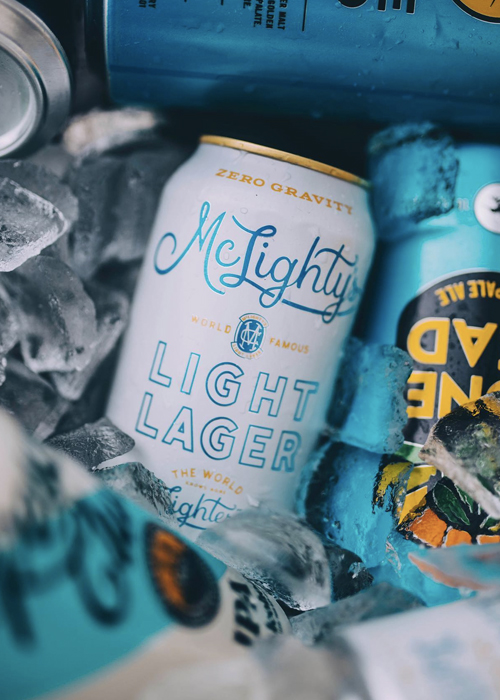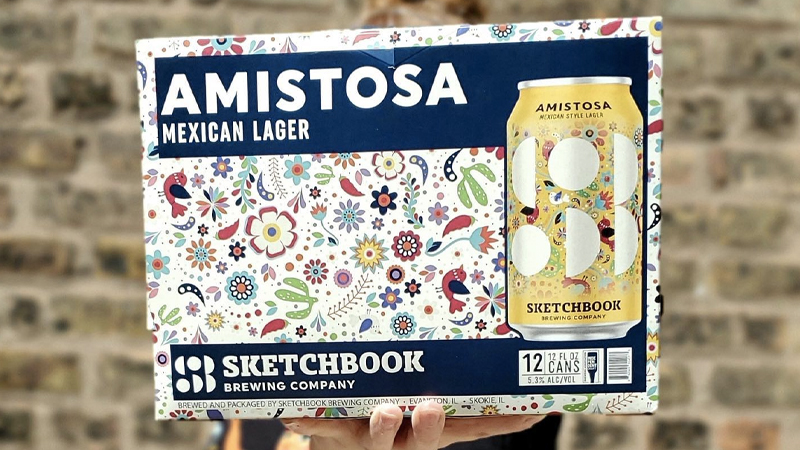When Zero Gravity released McLighty’s Light Lager this spring, the Burlington, Vt., brewery hoped every little number would have a huge impact. The lager’s retro-leaning label touted 90 calories and a 3.2 percent ABV, appealing metrics for folks looking to crush a couple beers and keep waistlines and wits in check.
But the most significant number for McLighty’s might be 12. Zero Gravity launched the lager in 12-packs of 12-ounce cans, a format favored for mainstream lagers stacked in supermarket aisles. That was precisely the point, says Matt Wilson, a co-founder and the CEO of Zero Gravity.

“To me, that’s the format for that beer,” Wilson says. “Get a bunch of them and keep them cold. It’s 3.2 percent, so you’ll want to drink several.”
Over the last five years, the 16-ounce can has become the craft brewing industry’s preferred package, a gleaming vehicle for delivering drinkers hazy IPAs wrapped in Instagrammable labels. The aluminum medium became the message, so ingrained that most folks forgot to ask a question: Is the 16-ounce can ideal for every beer? I’m no beer-drinking snail, but I have a tough time taking down a pounder of good pilsner before the last ounces go warm and flabby. Give me a 12-ounce can, please.
“I’ve started to become that way too,” says Cesar Marron, the head brewer and managing partner of Sketchbook Brewing in Skokie, Ill. “If it’s a hot day, maybe fishing on a boat, I want a 12-ounce can. A 16-ounce can will warm up.”
Instead of offering complimentary koozies with every 4-pack, craft breweries are downsizing lagers in 12-ounce cans. After years of waging liquid warfare against the multinational lager makers, four cans at a time, craft breweries are realizing that 12 might be the magic number for moving more lager.
“There’s always been an argument to be made that putting down a colder 12-ounce can is appealing to a lot of people,” says Rob Day, the vice president of marketing for Jack’s Abby Craft Lagers in Framingham, Mass., which offers both 12- and 15-packs of lager.
Craft Brewers Embrace Bulk Packaging
Historically, craft brewing has used packaging to communicate contrarian flavor. In the 1980s and 1990s, brown glass bottles were counterpoints to green-glass European imports like Heineken, as well as canned domestic lager. Early craft beers looked and tasted different. Sixteen-ounce cans continued that narrative, and customers flocked to breweries for 4-packs snapped into PakTech carriers. Cans became status symbols flaunted across social media. Look, I caught that dry-hopped whale!
What simpler times. When the pandemic hit in early 2020, shopping behavior shifted overnight. Instead of snagging local 4-packs on Saturday brewery crawls, drinkers hit supermarkets for 12-packs of toilet paper and beer, then hunkered down indoors.
Market upheaval led smaller breweries to bulk out with 12-packs of lager. Bunker Brewing in Portland, Maine, is best known for Machine, a Czech-style pilsner that’s typically sold in 4-packs of 16-ounce cans. But as viral waves eroded business, co-founder Chresten Sorensen faced an unfortunate reality: “We had all these tanks full of beer, and no one was going out,” Sorensen says.
This February, as a hedge against a continually uncertain future, Bunker began selling 12-packs of Machine in 12-ounce cans. “It creates another outlet for our beer,” Sorensen says.
A 12-pack can also create new sales opportunities. Store shelves teem with 4-packs, and there’s rarely space for another release. But at chain grocery stores, 12-packs occupy different real estate, creating opportunities to find a separate home for the same beer.

In fall 2021, Sketchbook began packaging Amistosa, its Mexican-style lager, in 12-packs that found ready placements at Illinois supermarkets such as Jewel-Osco. Even if stores are full up on 4-packs, they might “have room on the 12-pack aisle for craft beer,” Marron says.
When you’re selling outside the taproom, the right format matters. At first, Zero Gravity packaged its Green State Lager in 6-packs of 12-ounce cans, but “we would miss a lot of consumers’ eyes,” Wilson says. Around 2018, the brewery shifted Green State into tall boys, as well as 12-packs of 12-ounce cans. “It was the best thing we ever could have done,” Wilson says. As the world went upside down in 2020, “we were positioned as one of the craftier brands that had a 12-pack of beer.”
Size Matters for Sales Differentiation
Packaging trends can change quickly in craft beer. My closets are crammed with has-been 64-ounce glass growlers, and breweries have also largely phased out the 22-ounce bomber, an always awkward size.
“The 22-ounce bottle is a terrible format,” says Kevin McGee, the president and CEO of Anderson Valley Brewing in Boonville, Calif. “It’s not quite two beers, so you’re either drinking too much warm, flat beer by yourself or you’re kind of shorting your friend.” This fall, Anderson Valley is putting its 22-ouncers out to pasture and plans to package everything in 12-ounce cans, including its latest year-round release, The Pilsner.
“The bottling line will be packed up and shipped to a local winery,” McGee says.
Sometimes 12 ounces is too much. In early 2019, Chicago’s Hopewell Brewing debuted the low-alcohol lager Lil Buddy in 8-ounce cans, regularly served at bars and restaurants alongside a shot or maybe a Bloody Mary. But when demand for cans climbed during the pandemic, 8-ounce cans “were the first on the chopping block, so to speak,” says brand director Jake Guidry.
With production now resumed, Hopewell revived Lil Buddy this August with a colorful new label and wee price tag: $6.99 per 4-pack. “It opened up a whole new demographic for us,” Guidry says, relaying one anecdote about a woman in her 60s. “She told me, ‘I’m so glad this beer is here because I never want to have a full beer. This is the perfect size for me.’”
Not every brewery is downsizing. This year, Hi-Wire Brewing ditched 12-ounce cans and began exclusively packaging beers such as Hi-Wire Lager and Hi-Pitch Mosaic IPA in 16-ounce cans, sold by the 6-pack. Upping the volume and value — 6-packs are around $11.99 to $12.99 — “helps us to stand out on the shelf, especially outside of our home market,” says Brian Laggis, the sales director for the Asheville, N.C., brewery.
Offering lots of liquid for a moderate price requires a brewery to have the necessary production volume. Larger batches can create greater efficiencies, keeping costs in check. Even then, there’s a certain price ceiling to a 12-pack of beer. Customers regularly spent $20 and up on 4-packs of the latest hoppy whatever, but breweries can’t apply the same price-per-ounce to a 12-pack. We’ve not quite entered the era of the $45 12-pack.
At stores, Sketchbook’s Amistosa lager might sell for $10 per 4-pack of 16-ounce cans, while a 12-pack runs around $20. “The margins on 12-packs will always be lower,” says Marron of Sketchbook.
But bang for your buck doesn’t guide every consumer decision. “In our most mature markets, we’re selling about the same number of cases of both 12-packs and 4-packs,” says Wilson of Zero Gravity.
Maybe you want a tall boy while watching a band, then crush ice-cold 12-ounce lagers while tailgating. Or is tonight the night for a 19.2-ounce stovepipe of double IPA? Breweries will continue to mix and match packaging, rolling the dice for winning numbers.
“At the end of the day, the business of craft beer and the people drinking craft beer is changing,” says Hopewell’s Guidry. “You’ve got to adapt.”
This story is a part of VP Pro, our free platform and newsletter for drinks industry professionals, covering wine, beer, liquor, and beyond. Sign up for VP Pro now!
